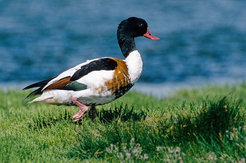Healthy animals – healthy humans
People now travel around the globe in just a few hours. And dangerous pathogens accompany them. But bacteria and viruses are not just stowaways on planes and in ships – animals also spread them around the world.

This is frequently not a problem for the animals themselves; however, some of these pathogens pose a major risk to humans. Many fatal infections, like Ebola, HIV or influenza, originally stem from animals. When humans and animals live in close contact, the germs can easily jump to humans. In Asia and Africa in particular, humans and animals live in close proximity, often even in the same room. Such cases are particularly dangerous and often trigger symptoms of a fatal disease.
Pathogens frequently cover thousands of kilometres in the company of migratory birds, marine animals or hoofed animals. While they can infect humans directly, a more likely scenario is the transfer to household pets, as viruses and bacteria are well adapted to the domesticated relations of their original host. They can then move easily from household pets to humans.
For a number of years now, scientists have been using computer models to calculate the spread of epidemics based on the global airline network. However, it is not only the routes travelled by humans that play a role in the spread of disease; the movements of animals are also increasingly important in the prediction of epidemics.
H5N1
For example, between 2005 and 2010, an international team of researchers studied the outbreaks of the H5N1 virus among wild and domestic birds, a virus that is also dangerous to humans. They then compared the outbreaks with the flight paths of two bird species. The scientists tracked the flight paths of the bar-headed goose (Anser indicus) and the common shelduck (Tadorna tadorna) with the help of GPS transmitters. Their research showed that the water birds fly together with many other species from India and Bangladesh in a northward direction over Tibet and China to Mongolia. Most of the outbreaks that occurred among poultry in South Asia during the period studied were also on this flight path. According to the results, the bar-headed geese and the common shelducks could transport many viral strains from an arbitrary bird resting area in Central China to Mongolia.

The scientists assume that the common shelduck is infected by poultry in its wintering areas in Bangladesh. The bar-headed goose, on the other hand, comes into contact with the H5N1 pathogen mainly in the Tibetan capital of Lhasa and brings it from there to China. The study shows therefore where the wild birds are likely to be infected and consequently where the contact between wild and domestic animals should be prevented. This contact arises primarily due to the fact that poultry are driven to graze on harvested rice fields or swamplands and forced to come into contact with their wild relatives.
But the avian flu is not only rife in Asia: in the winter of 2005/2006, wild birds in Europe also fell victim to the virus. The extraordinarily low temperatures during this winter probably increased the risk of infection, as the cold causes water birds to move particularly close together. However, scientists still do not know which route was taken by the pathogen from Asia to Europe and who brought it to Europe.
It is hoped that Icarus will now help determine the flight paths of other bird species and thus the way in which viruses are spread. Scientists participating in the Icarus project want to attach transmitters to northern pintails (Anas acuta) and mallards (Anas platyrhynchos) in Siberia for example and observe them on their flights to their winter quarters in tropical Africa, India and Southeast Asia. The results that they obtain will reveal not only the routes taken by infectious diseases but also the spread of antibiotic-resistant bacteria. Mallards are particularly susceptible to being infected with antibiotic-resistant bacteria by their relatives in poultry farming.
Fruit bats

Although prominent in the news, the role of bats in the emergence of zoonotic diseases remains poorly understood. Despite a large research effort, the complex interplay between bats, viruses and other wildlife, and impacts of human encroachment in intact ecosystems on these interrelations, remains elusive. Movement studies are crucial to investigate if and where there is a high potential for bats to come in contact with viruses and other wildlife, and which role this might have for viral dynamics and disease transmission. Icarus makes long-term tracking of African fruit bats possible, allowing us to identify new roosting locations, understand resource requirements, and monitor bats throughout their migratory cycle.
The health of millions of people around the world could thus be protected if the necessary knowledge about animals and their migrations were available. For this to become a reality, however, researchers need to know even more about the behaviour and routes of a wide variety of species. This can only be achieved with a global satellite-based system like Icarus, which can observe thousands of animals using transmitters and analyse the data in real time.


